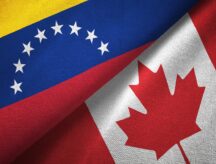U.S. immigration policies pushing tech talent to Canada
Pour lire cet article en français, cliquez ici.
Mezyad AlMasoud holds two master's degrees and is the CEO of a company that manages money for professional athletes. He is also one of the highly skilled immigrants forced to leave America because of immigration reforms in 2017.
AlMasoud had wanted to go to America since he was a child growing up in Kuwait.
“I had been loving the U.S. [I watched] NFL football, and I’m a big fan of many of the musicians of course,” he told CIC News.
In 2015 he moved to America with a temporary visa called the Optional Practical Training (OPT). He then started his company, Flair Inc. a year later in 2016.
At the time, AlMasoud could count on an Obama-era immigration program called the International Entrepreneur Rule (IER) to allow him to stay in the U.S.
However, in 2017, President Donald Trump's administration moved to rescind the IER program. AlMasoud was told he would have to leave the country.
“It was a very sad moment for me,” AlMasoud said. “I was kind of confused and I didn’t know what to do next, and that’s when I started thinking about other opportunities.”
Data from the 2016 U.S. presidential election onward also show that more and more temporary skilled worker petitions for new employment, known as the H-1B, are being denied to foreign workers in the U.S.
The rates have shot up from six per cent in 2015 to 32 per cent in the first quarter of 2019, according to the National Foundation for American Policy.
Meanwhile, it's a different story in Canada, where federal and provincial programs are opening their doors to the international tech talent like AlMasoud.
The number of employees in the professional, scientific, and technological sector rose by 4.5 per cent between 2017 and 2018, according to Statistics Canada, and immigration is expected to be an important element of labour force growth over the next two decades.
It was a friend from business school who suggested that AlMasoud should move to Canada. He applied for the Entrepreneur Start-up Visa Program and his application was processed in about a month, he said.
In February 2018 he landed in Vancouver, B.C., where he has been ever since.
“I am going hiking from time to time at least once per month,” he said. “And the food is amazing, and the community is very diverse ... I have many new friends, so it’s great.”
Find out if you are eligible for any Canadian immigration programs
Canada taking in talent denied by U.S.
The friend who encouraged AlMasoud to consider Canada was Jake Tyler, co-founder and CEO of Finn AI, a Vancouver-based company offering artificial intelligence solutions to banks around the world.
The two knew each other from their studies at the IE Business School in Spain.
Tyler, who hails from Australia, co-founded Finn AI with fellow immigrant Guru Altu from India and Canadian entrepreneur Nathalie Cartwright, who serves as chief operating officer. Like AlMasoud, both Tyler and Altu were able to build their business in Canada via the Entrepreneur Start-up Visa Program.
Cartwright told CIC News that immigrants make up a significant portion of the Finn AI talent pool and she recently hired someone who has a story similar to AlMasoud.
“We have hired someone who was kicked out of the U.S. who was an exceptionally talented data scientist,” she said. “We were able to take advantage of that opportunity and get them a position in Canada.”
Canada’s Global Talent Stream has allowed the company to bring in skilled foreign workers in as little as two weeks. Cartwright got to see the process in action while hiring one of Finn AI’s most recent employees.
“They got the approval within four days and were here within two weeks,” Cartwright said. “That certainty of bringing people in means we can find international talent.”
A spokesperson with Finn AI reports that 54 per cent of their Vancouver office is comprised of immigrants. The company's Toronto office currently has one employee, and the New York location is made up of three salespeople who are either American or hold American work permits.
While Cartwright said she doesn’t have much experience hiring international workers via the American immigration process, she describes it as “long” and “uncertain.”
“There’s a lot of uncertainty both for the individual and the company,” Cartwright said. “When we’re looking to hire someone, six months [of processing] is too long.”
American companies also report finding it easier to hire immigrants at their Canadian locations.
Thor Kallistad, the CEO of DataCloud, described Canada's immigration policies as more "sane."
DataCloud offers tech solutions to the mining industry and operates in California's Silicon Valley and in the Canadian province of British Columbia, which has a robust mining sector.
"It's very convenient ... that the biggest drivers for [our business] happen to be in B.C.," he told CIC News from his office in California. "And on top of that, the immigration is a more predictable policy to get people in, which has worked out well for us."
U.S. losing talent to Canada before Trump
Emmanuel Delaporte moved to Boston, Massachusetts, from France in 1999. The company where he worked as an IT analyst was sponsoring his American permanent residency application.
Delaporte needed to be employed by this particular company until he obtained his U.S. Green Card, or permanent residency status.
In 2004, Delaporte realized the company was not doing well and the possibility of losing his job would put his Green Card application at risk. He would either need to start the process all over again with a different company, or leave the country.
“I was not kicked out of the country,” Delaporte said. “I knew that it would be difficult for me to stay so I decided to prepare my exit before I was in a difficult situation.”
He started his application for a Quebec Selection Certificate and one year later, in 2005, he moved to Montreal, Quebec.
“I had no job offer... in Quebec, and Canada, you can apply just with your credentials and who you are and your resume,” Delaporte said. “You don’t need a company.”
Today Delaporte is still in Montreal, and working at CGI, a world-renowned IT consulting company.
“I’ve been here almost 15 years now,” he said. “I’m a local now.”
Delaporte would not name his former U.S. employer but said that the company has since closed.
'A feeling of freedom'
Andrei Charepka, from Belarus, is a software developer at a company that makes electrical systems for the aerospace industry. He and his wife, who is originally from Russia, live in Ottawa, Ontario, where they settled after eight years of working in the U.S.
Charepka met his wife at an American summer camp where they worked in 1998. Soon after they tried to get into Canada by applying for a student visa but at the time they did not have enough funds to qualify.
Instead, Charepka did his Bachelor of Science in the U.S., but the goal was always to come to Canada.
“After staying in the States for several years it became clear that there was no future for us,” Charepka said. “I could renew the [temporary] visa again but it didn’t seem reasonable that I could get a [Green Card] there… and [Canada] had an actual immigration program that we would qualify for and be able to come here.”
After graduating he was on the H-1B temporary work permit, that he had to keep renewing every three years.
“If you stay with the same employer, the employer can apply for a Green Card,” Charepka said. “It’s a lot of effort on the part of the employer to prove that the candidate can’t be found locally.”
When he and his wife finally applied to Canada’s Federal Skilled Worker Program, Charepka said it took about a year and a half to process his application. With Charepka as the principal applicant they were able to come to Canada in 2006.
“It was a weird feeling because it was a feeling of freedom... because we finally found a place where we belong,” Charepka said. “With the PR status we could come and go in peace. We felt that we were full members of society.”
Find out if you are eligible for any Canadian immigration programs
Pour lire cet article en franćais cliquez ici.
© 2019 CIC News All Rights Reserved
- Do you need Canadian immigration assistance? Contact the Contact Cohen Immigration Law firm by completing our form
- Send us your feedback or your non-legal assistance questions by emailing us at media@canadavisa.com







